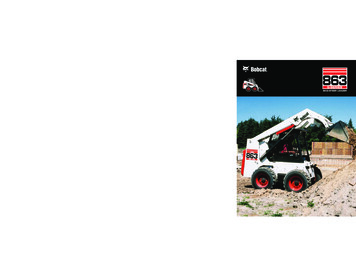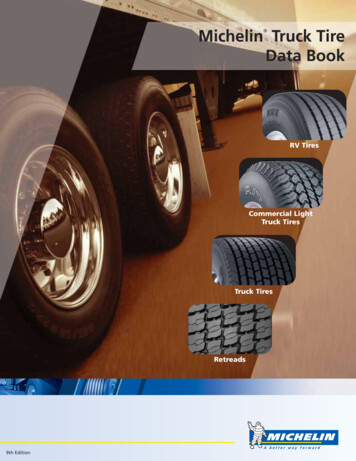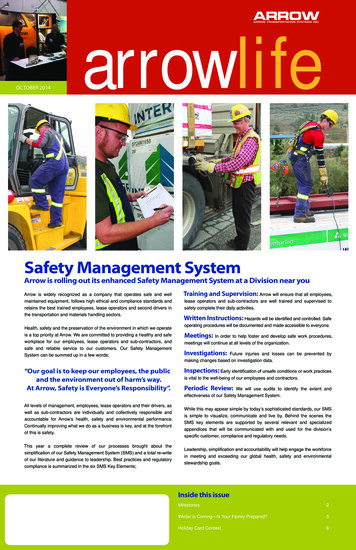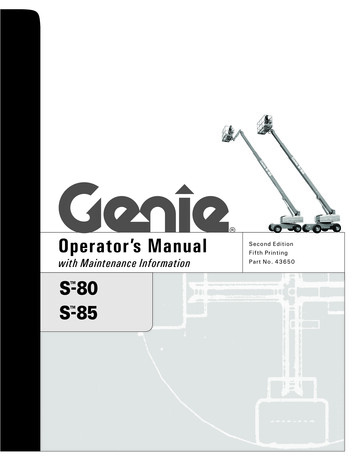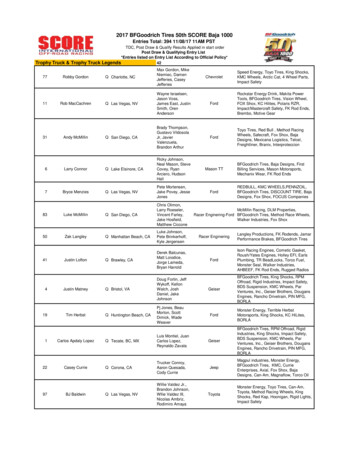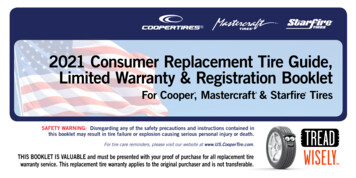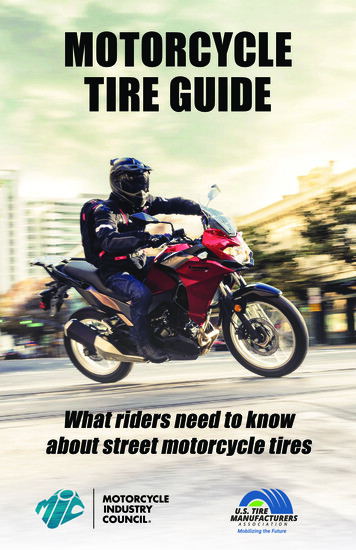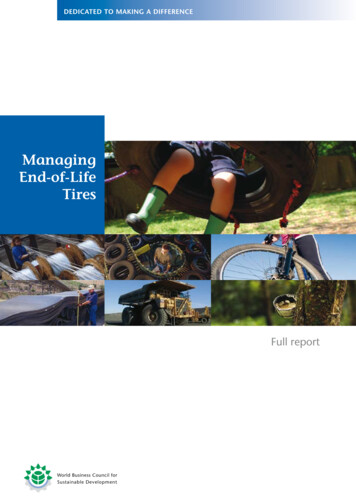
Transcription
ManagingEnd-of-LifeTiresFull reportWorld Business Council forSustainable Development
ContentsWBCSD Tire Industry Project: An introductionThe life of a tire: Facts and trends12What are tires made of?What is the environmental impact of a tire during its life cycle?What is an end-of-life tire?End-of-life tire generation and recovery worldwideHow does the end-of-life tire recovery rate compare with other goods?End-of-life tire uses:Numerous possibilities, existing and under development6Why use end-of-life tires and for what purposes?Energy recoveryMaterial recoveryOther innovative and emerging uses for end-of-life tiresManagement systems for collectingand recovering end-of-life tires11Tire industry responsibilityGovernment/community responsibilityFree market approachLandfill and waste pilesEnd-of-life tire management in developing regionsWhat is the future outlook?Useful resourcesPhoto credits:Copyright:ISBN:Printer: Lebanmax – Fotolia.com www.guardian.co.uk/business/gallery/2007 WBCSD, November 2008978-3-940388-31-5Atar Roto Presse SA, Switzerland Printed on paper containing 50% recycled content and 50% from mainly certified forests (FSC and PEFC).100% chlorine free. ISO 14001 certified mill.1314
WBCSD Tire Industry Project:An introductionToday, when people think of the environmental impacts of tires, they mostly focus on themanagement of tires at the end of their useful lives (end-of-life tires, or ELTs), as this topicusually draws the most public attention.Globally, an estimated one billion tires reach the end of their useful lives every year.Disposal of ELTs in environmentally sound and productive ways continues to be a highpriority goal of the tire business. Various regional efforts by governmental authorities, thetire industry and individual manufacturers are currently underway to address the issue ofELTs, and good progress is being made.ELT recovery provides cost-effective and environmentally sound energy for severalindustries. It also provides innovative materials for civil engineering projects. ELTs canreplace other limited natural resources.The Tire Industry Project (TIP), under the auspices of the World Business Council forSustainable Development (WBCSD), has put together this overviewto explain what ELTs are, what environmental impacts they can have, and what has beenand can be done to ensure they are properly managed.ELTs have a variety of uses and they are increasingly being viewed as a resource instead ofa waste. Environmental issues continue to be a driving force behind ELT recycling, and asthe recycling industry develops with legislative and infrastructure support, it is becomingclear that there can be significant benefits.A summary version of this report is available atwww.wbcsd.org/web/tires or from tires@wbcsd.orgEnd-of-life tires: Fast factsnnnnnnnOne passenger tire per person is discarded each year in the developed world1 billion ELTs are generated globally each yearAn estimated 4 billion ELTs are currently in landfills and stockpiles worldwideELTs are a resource that can be used in place of virgin materials, reducing natural resource depletion andlowering environmental costs associated with natural resource exploitationELTs can replace traditional fossil fuels in some applications and may reduce NOx, SOx and CO2 emissionsELTs can also be used in civil construction projects as ground or crumb rubber, and as a substitute for coal insteel plantsThe ELT recovery rate is now more than 84% for Europe, the US and Japan1
Facts andtrendsThe life of a tire: Facts and trendsWhat are tires made of?A typical passenger tire contains 30 types of syntheticWhat is the environmental impactof a tire during its life cycle?rubber, eight types of natural rubber, eight types of carbonAlmost all of the environmental impact of a tire occursblack, steel cord, polyester, nylon, steel bead wire, silica andduring the use phase, primarily as a result of vehicle fuel use40 different kinds of chemicals, waxes, oils and pigments.and carbon dioxide emissions due to rolling resistance. TireThey typically contain 85% hydrocarbon, 10-15% iron (inwear and road wear debris contribute to a lesser degree tothe bead wire and steel belts) and a variety of chemicalthe environmental impact of the use phase. Raw materialscomponents. Vulcanization (a technique for hardeningproduction and tire manufacturing account for the nextrubber, making it more durable), the introduction of radialgreatest impact. While recovering and reprocessing end-tires in the 1950s and other advances, including compoundof-life tires have a small environmental impact, it is a visiblerevisions for greater durability and longer tread life, meantone, and of concern to many stakeholders. Distributionthat by 1995 an estimated 2% of recycled material was(transportation) has a small impact.being used in tires. Today, the use of recycled rubber isgradually decreasing as the properties of recycled rubberhave a negative impact on performance (for example onWhat is an end-of-life tire?fuel consumption).A tire is considered at the end of its life when it can nolonger be used on vehicles (after having been retreaded orregrooved). All tires including passenger car, truck, airplane,two-wheel and off-road tires result in ELTs. However, thebulk of ELTs result from car and truck tires.Figure 1: The composition of an average vehicle tireSource: ETRMA 2001High-strength steel cords areapplied under the tread of passengercar tires (and in the carcass oftruck tires) while other steel wiresare located near the bead toassure adherence to the rimCarbon black and silicaare the basic tire fillers,providing the necessary“structure” to the compoundOther chemicals have variousfunctions, like oils, zincoxide or anti-degradants toprotect the compoundSynthetic rubber is addedto natural rubber to achievethe desired elasticity2Passenger car tires featurerayon or polyester cords radiallydisposed along the carcass(“radial tires”), while nylon cordsare placed under the treador near the bead areaNatural rubber has unique elasticproperties and is an essential elementof a tire. Truck tires have an evenhigher natural rubber contentthen passenger car tires
Facts andtrendsEnd-of-life tire generationand recovery worldwideOver the last 15 years recovery rates for ELTs havedramatically increased in Europe, Japan and the US. JapanFigure 2: Historical recovery rate estimates for ELTsSources: Estimates based on data from European Tyre & Rubber Manufacturers’Association, Rubber Manufacturers Association and Japan Automobile TyreManufacturers Association Inc.started recycling programs even earlier. At the same time,10090some areas due to both increased efficiency in management80structures and new recovery routes. This shift shows thatELT-derived products can legitimately be recognized as avaluable secondary raw material or an alternative fuel.ELT generation and recovery rate estimations are not alwaysavailable and not always uniform in content. Reuse andretreads are sometimes included in recovery rates. Stockpileabatement programs also affect the recovery rate.Country-to-country comparisons are therefore not alwaysprecise. However, for an idea of general trends andestimates, the following information may be useful. TheWBCSD welcomes further information from interestedparties to update this data.Percentage recovery ratethe cost of recycling to the consumer has decreased in706050403020Millions of ELTs generatedper year (including exportand retread)EuropeJapanUSA317 (2006)103 (2006)299 (2005)1001994 1995 1996 1997 1998 1999 2000 2001 2002 2003 2004 2005 2006YearEurope (EU27) adjusted to remove exports and retreadsJapan adjusted to remove exports and retreadsUSA adjusted to remove exportsFigures for Europe and Japan exclude exports and retreads,figures for USA exclude exports3
Facts andtrendsFigure 3: Millions of end-of-life tires generated each year292250112China22Canada80Europe23USASouth 0South AfricaAustralia12New Zealand4Energy recoveryCivil engineering uses or material recoveryLandfill, stockpiled, discarded waste or otherSpecific reuse/disposal/recovery data not availableOf those tires that do not go toMillions ofexport or retread, they are destined for:ELTs geneCivil engineering Landfill, stockpiled,rated per year Energyrecovery uses or material discarded waste(excluding exportor other (%)(%)recovery (%)and y datanot availablen/aYearSources2005Estimates based on data fromRubber Manufacturers Association (RMA)2006Estimates based on data from European Tyre & RubberManufacturers' Association (ETRMA) Europe(EU 27 plus Norway and Japan80701515n/a2006Estimates based on data from Japan Automobile TyreManufacturers Association Inc. (JATMA)Mexico3009010n/a2004"Mexico pays cement industry to burn scrap tires"www.ecoamericas.comm/en/story/.aspx?id 569Brazil27691318n/aSouth Korea2377167n/a2003Korea Tire Manufacturers Association (KOTMA)Canada2220755n/a2003Pehlken A. and E. Essadiqi, Scrap Tire Recycling in Canada, 2005.Australia2022870n/a2006URS, Market Failure in End-of-life Tyre Disposal, report for theDepartment of Environment and Heritage, September 2006Malaysia14n/an/an/a100South Africa12n/an/an/a1002003Iran10n/an/an/a1002006Iran daily newspaper m)2003Ministry of the Environment, Israel "Waste Tires : A Case Study",Environmental e-bulletin September 2003, Issue 2(see also www.sviva.gov.il)Israel7n/an/an/a100New Zealand401585n/aVarious newspaper articles including Recycling Today andHong Kong Trade Development CouncilAssociação Nacional da Indústria de Pneumáticos (ANIP),Instituto Brasileiro de Geografia e Estatística (IBGE)(see also ex.html).What to do with old tires? Lim J."Fixing a Tyred Environment", Die Burger, 6 April 2003Estimates taken from "Product Stewardship Case Study for Endof-Life-Tyres" by URS for the Ministry of the Environment (NZ) 2006For USA, Europe and Japan, ELTs destined for export and/or retread are excluded from the volume of ELTs generated per year.4
Facts andtrendsIn Europe, the End-of-Life Vehicle Directive sets targetsof 95% recovery/reuse of vehicles by 2015. Because ofthe high value relative to recovery cost, many Europeancountries are already achieving recovery rates of 75 to84%. Scrap metal tends to be recovered most often.Vehicle manufacturers are also encouraged to fulfill theirtire recycling obligations according to these targets. In2007, the European Commission adopted the Report onthe Implementation of Directive 2000/53/EC on End-OfLife Vehicles for the period 2002-2005 (www.ec.europa.eu/environment/waste/elv index.htm).How does the end-of-life tire recovery ratecompare with other goods?Waste generation in the EU is estimated to stand atover 1.43 billion tons per year and is increasing at ratescomparable to those of economic growth. ELTs make upabout 0.2% of this waste (ETRMA Annual Report 2007).Recycling and recovery rates for ELTs are generally far higherthan for most other consumer goods.Table 1: ELT recovery rate compared with other goodsRecyclingrateEurope (%)MaterialRecycling RecyclingraterateUS (%)Japan (%)18628534225906998Tires84Glass65Steel containers63 963 1087.5 11Aluminumbeverage cans52 1252 1392 14PET bottles39 1524 1666 17“For over ten years, we have been committed to setting upa structured, efficient management system for ELTs.In Western Europe, recovery rates increased from 65%in 2001 to almost 90% in 2005. There are increasinglynumerous applications for recovered tires: in some countrieswhere we did not know what to do with ELT a few yearsago, now we do not have enough to meet the demand ofthe reprocessors.”Paper/cardboard641850196620Serge Palard, Chairman and CEO of AliapurCar batteries90 (UK)7Recovery rates for tires are estimated on the basis of ELTs generatedexcluding ELTs destined for export and retreat5
ELT usesEnd-of-life tire uses: Numerous possibilities,existing and under developmentWhy use end-of-life tires and for what purposes?ELTs can be a low-cost source of fuel when located nearFigure 4: Current uses for ELTsa major fuel consumer, such as a power plant or cementAlternative fuel (mainly for cementkilns, paper/pulp mills, thermalpower stations, industrial boilers, etc.)factory. They can also be readily processed for a diverserange of construction projects. Substituting ELTs in place ofnew raw materials reduces associated environmental andeconomic costs, such as: Exploration and mining for fossil fuels and other virgin rawEnergyrecoverymaterials, and the associated land-use impact Transportation requirements (as tires are usually plentifulSubstitute for coal in steel plants(for example, electric arc furnacesare an emerging use)everywhere) Most or all processing requirements for many applications(as tires can often be used whole or shredded).Construction material1) Energy recoveryTire derived fuel (TDF), one of the leading options for ELTs,Materialrecoveryis mainly used in cement kilns, but also in thermal powerstations, pulp and paper mills, steel mills and industrialCrumb or ground rubber applications(including molded products whencombined with thermoplastics)boilers. In Europe, the cement sector is the main use of TDF.Kilns are increasingly being equipped to use ELTs assupplementary fuel and still be in compliance with the 2008atmospheric emission standards. Tires have a high energycontent and are an equal or better source of energy thanmany other solid fuels. This, alongside rising energy costsand increased environmental awareness in recent years,has led to an increase in use of TDF. The infrastructureexists, and with sufficient support and recognition of TDFas a viable alternative, the development of the industry hasFactors affecting the use of ELTs include:n The ELT recovery and management structure in placen Standards and restrictions on ELT use and disposaln Infrastructure available to allow reusen Reliability of supplyn Transport needs and costsignificant potential. TDF is currently the biggest use for ELTsin the US and Japan, and energy recovery is about equal tomaterial recovery in Western Europe and the US.Sources: European Tyre & Rubber Manufacturers’ Association, Rubber ManufacturersAssociation and Japan Automobile Tyre Manufacturers Association Inc.Table 2: ELT usage as tire derived fuel (TDF)Total ELTs(excludingexport andretread)EuropeJapanUS6TDF usageFacilities with TDF utilization250 million41% (2006)Cement kilns80 million70% (2006)Cement kilns, paper mills, tire factories292 million53% (2005)Cement kilns, paper/pulp mills, boilers
ELT usesTotal ELTs(excludingexport andretread)EuropeJapanUSTDF usageFacilities with TDF utilization250 million41% (2006)Cement kilns80 million70% (2006)Cement kilns, paper mills, tire factories292 million53% (2005)Cement kilns, paper/pulp mills, boilersTires sent for co-processing in a cement plant where both fuel value and materials are recoveredTable 3: Tire company furnaces fueled by TDF in JapanCompanyFactorySources: Japan Automobile Tyre Manufacturers Association Inc. (JATMA)Incinerator typePurposeBridgestone Corp.Tochigi plantAmagi plantFluidized-bed incineratorGrate incineratorPower generationHeat source for boilerYokohama Rubber Co., Ltd.Mie plantGrate incineratorHeat source for boilerSumitomo Rubber Industries, Ltd.Nagoya plantShirakawa plantMiyazaki plantGrate incineratorPyrolysis incineratorGrate incineratorCogenerationHeat source for boilerHeat source for boilerToyo Tire & Rubber Co., Ltd.Sendai plantKuwana plantGrate incineratorGrate incineratorCogenerationHeat source for boiler7
ELT usesThe advantages of TDFnLower costTires have a high energy content and TDF is an equal orThe cost of TDF is significantly lower than that ofbetter source of energy than other fuels:fossil fuels such as natural gas, coal and petroleumcoke, especially when exploration, development andTable 4: Energy content and CO2 emissions from fuelsSource: Greenhouse Gas Protocol Initiative, WBCSD CSI CO2 Emissions InventoryProtocol, Version 2.0FuelEnergy(Gigajoule/tonne)transport costs of virgin materials are taken intoaccount.Provided that quality and supply can be maintained,Emissionsusers can incorporate TDF into long-term planningkgCO2 /tonnekgCO 2 /Gigajoulesuch that significant economic advantages can beobtained. Tires are frequently a low-cost fuel sourceTires32.02,27085for cement factories. Weight and volume limitCoal27.02,43090transport distance and availability.Pet coke32.43,240100Diesel oil46.03,22070Natural gas39.01,98951Wood10.21,122110‘‘TDF can be used successfully as a 10-20% supplementaryfuel in properly designed fuel combustors with goodcombustion control and add-on particulate controls, suchas electrostatic precipitators, or fabric filters. Furthermore,a dedicated tire-to-energy facility specifically designedto burn TDF as its only fuel has been demonstrated toachieve emission rates much lower than most solid fuelcombustors.”Cement kilns are able to use either whole or shreddedtires. For other uses of TDF, such as in pulp and papermills, the steel belts often need to be removed to allowthe ash waste to be resold. However, even then, therecycled steel is a valuable by-product.TDF can be a good use for stockpiles of contaminatedtires covered in dirt and water. These tires cannotgenerally be used for ground rubber and so TDF orconstruction projects are better options.EPA Research Paper, Air Emissions from Scrap Tire Combustion, 1997nReduced emissionsTDF emissions, when tires are burned in a controlledenvironment, are no greater than those produced byother fuels. The carbon content per unit of energy isless than coal and petroleum coke, offering potentialreductions in greenhouse gas emissions. In somesituations, using TDF instead of virgin fossil fuelsreduces nitrogen oxide, sulfur oxide and carbon dioxideemissions. Natural rubber content in tires (25% or more)is regarded as carbon neutral, as rubber plantationssequester carbon from the atmosphere during their lifetime. Any ash created generally contains fewer heavymetals than ash from coal combustion. In cement kilnsthe rubber provides energy and the iron and sulfur areincorporated into the cement. (Iron is normally addedto the cement-making process; sulfur is absorbed andconverted to sulfates.)8Caption: Scrap tire incineration power generationsystem at Bridgestone Tochigi plant in Japan.
ELT uses2) Material recoverynnGround rubberIt is likely that ground rubber use will expand withCivil engineering usesfurther research and development. For example, methodsWhole or shredded tires are successfully used in a varietyof blending recycled rubber with polymers to createof civil engineering projects such as embankments,molded goods are improving, as are techniques tobackfill for walls, road insulation, field drains, erosionimprove rubber use in asphalt in varied climates.control/rainwater runoff barriers, wetlands and marshAsphalt pavements made with ELTs are in common useestablishment, crash barriers and jetty bumpers. Tiresin the developed world and beneficial properties includeare excellent materials for such uses because they arelonger life spans and reduced noise. In the US, groundlightweight, permeable, good insulators, shockrubber is blended with asphalt to favorably modify theabsorbent, noise absorbent and durable.properties of the asphalt. This market has expanded inthe US and Europe, and is anticipated to grow in theAnti-scree wall in the Hautes Alpes, FranceSource: Aliapur, DRArtificial turf on playing field, FranceSource: MichelinELTs can also be converted into ground or crumb rubberfuture. For example, several Canadian provinces arethat can then be used for rubber-modified asphaltconducting research that could lead to further(resulting in reduced traffic noise), running tracks, sportsexpansion of this market.fields, ground cover under playgrounds, molded rubberproducts, and mulch in landscape applications. GroundThe Japan Asphalt Rubber Research Group has ledrubber is produced either by ambient grinding orresearch and development into rubber-modified asphalt.cryogenic (freeze) grinding, the latter producing finerTrial pavements have been laid showing ELTs to be anparticles by using liquid nitrogen to cool the tires beforeeffective recycling technology and an environmentallyprocessing.friendly, cost-effective pavement material. Growth in thisindustry is projected.In most uses, tires present a low pollution risk. Whencompared with other alternative materials, using ELTscan help minimize a project’s environmental impact. Insome cases leaching may possibly occur; however this isnot reported as a widespread problem.9
ELT uses3) Other innovative and emerginguses for end-of-life tiresOther innovative uses for ELTs are emerging as morenDevulcanizationresearch and development is carried out in this area. TheDevulcanization (the process of breaking down andfollowing technologies are in development or already usedrecycling rubber) methods include thermal, mechanical,in special circumstances.ultrasound and bacterial, and it can be used to makenmolded rubber products from ELTs. AlthoughElectric arc furnacesdevulcanization is usually cost prohibitive, someSteelworks equipped with electric arc furnaces provideapplications have been developed and researchan almost closed loop recycling possibility for ELTs.is continuing.The method involves applying a quantity of scrap metalinto an electric arc furnace, followed by a quantity of tiresnPyrolysis(shredded or whole), to convert carbon monoxidePyrolysis is the thermal decomposition of organicgas to carbon dioxide in the furnace. In the US, aboutmaterial in the absence of air, and is a potential way1.3 million ELTs are used in this way per year, and aof generating materials from tires. Limited pyrolysismarket also exists in Japan. More recently this applicationfacilities currently exist and large-scale development ishas been validated for industrial use in Belgium, Francenot currently economically viable.and Luxembourg, and it has the potential for growth inEurope.ELTs being shredded for reuse10
ManagingELTsManagement systems for collectingand recovering end-of-life tiresEnd-of-life tire management approaches vary. Threeprovinces. Nigeria and Turkey have also begun stewardshipmain frameworks, or combinations, are usually used.systems and Russia is currently considering proposals.1) Tire industry responsibility2) Government/community responsibilityTire manufacturers (often in collaboration with distributorsSpecific taxes are levied on tire sales, or taxpayer-fundedand retailers) take responsibility under stewardship systemssystems operate using general tax revenue. Governmentsfor the recovery and recycling or disposal of ELTs, andhave often taken a direct role in cleanup programs. In thefinance these according to the number of units sold withinUS, many states have active programs to clean up existingthat country. Such systems are typically administered by astockpiles and eliminate the creation of new ones.not-for-profit body. Most often a separate fee is charged atGovernment-administered bodies responsible for ELTs havethe time of original sale, which increases public awarenessbeen established in the half of the Canadian provinces notof the program and funds the activities.covered by stewardship systems. Industry and otherstakeholders are frequently involved.In some regions tire manufacturers have promoted ELTs asa resource and consequently have proactively pursuedCroatia, Denmark, Latvia and the Slovak Republic also haveproducer-responsibility systems. Most countries in Europetax-funded systems.now have these systems, accounting for over 50% ofEuropean ELT volume. ELT management companies3) Free market approachorganize collection and recovery, participate in research andELT enterprises operate independently. Where suitabledevelopment activities for new recovery routes, liaise withinfrastructure exists, these companies can arrange recyclinglocal authorities, comply with reporting obligations andand recovery of ELTs with commercial benefits. Austria,promote the introduction of product standards. In addition,Germany, Ireland, New Zealand, Switzerland, the Unitedthe European Tyre and Rubber Manufacturers AssociationKingdom and the US operate on free market principles. Such(ETRMA) has established “The Used Tyres Group“ tocountries usually have laws regarding the transportation, use,promote the principle of ELTs as a resource and to proposedisposal and storage of ELTs. Tire manufacturers and othersregulations and directives for their proper management.involved in the industry voluntarily participate in systems.In Japan, based on “The Fundamental Law for Establishing aIn the US, tire manufacturers work together through theSound Material-Cycle Society“, the Japan Automobile TyreRubber Manufacturers’ Association (RMA) to promoteManufacturers Association Inc. (JATMA) promotes the 3Rs –responsible management of ELTs and to develop markets forReduce, Reuse and Recycle – with its committees toELTs.coordinate ELT collection and recovery, and to encouragefurther research and development. JATMA has alsoIn addition, technical assistance is provided to prospectiveimplemented a program for the removal of illegal legacyusers of ELTs to assist in getting necessary governmentstockpile sites.approvals and to help new users get started.In Korea manufacturers and importers pay a deposit feethat is refunded if they collect the ELTs. Brazil requiresimporters to demonstrate the disposal of 20% more tiresper annum than they import. Stewardship systems (oftenwith government environment agency involvement) alsoexist in South Africa and about half of the Canadian11
ManagingELTsLandfill and waste pilesThe problems with landfilling and waste piles of ELTs areMost, but not all, developed countries now view landfillsthree-fold:(waste piles and dumps) as the least desirable option for ELTs.Tires are banned from landfills in the European Union. Elevenstates in the US place a total ban; a further 31 states haverestrictions requiring shredding or monofilling. ThreeCanadian provinces ban landfilling. Many other jurisdictionshave set non-binding goals to reduce or eliminate landfilling,especially of whole tires.1. Valuable resources are unused and therefore wastedwhen in stockpiles.2. Tires may catch fire and such fires are notoriously difficultand costly to extinguish. In California, US 20 millionwas spent on the recently completed cleanup of the 1999Westley tire fire when seven million tires burned. In 1990,In some situations, if municipal landfills are taxpayer-funded,14 million tires burned in one of the biggest fires everand recycling taxes do not exist, then landfill fees can be lessrecorded, in Hagersville, Ontario.than recyclers’ collection fees, for example in some parts ofAustralia. This provides a further incentive to recycle ratherthan landfill ELTs.Legacy stockpiles of ELTs present different issues to annually3. In certain climates, stockpiles are ideal breeding groundsfor mosquitoes. This can pose significant health risks asfatal diseases such as West Nile fever, dengue fever andmalaria have been linked to such breeding grounds.generated ELTs, and therefore require different managementpractices. While owners sometimes consider an ELTFire and infestation risks can largely be overcome (at extrastockpile to be an asset, they are also liabilities, due to thecost) if tires are shredded and/or buried. However, by doingpotential for fire and infestation (for example from disease-this, potentially valuable usable resources still becomecarrying mosquitoes). Stockpiled tires tend to remain in placeunnecessary waste. Additionally, buried whole tires can oftenuntil a government-initiated abatement program orrise to the surface or “float” and reduce the future usabilityenforcement efforts can be implemented.of a site.Another major issue in managing ELT stockpiles is developingstockpiles. This is called stockpile mapping and has beenEnd-of-life tire managementin developing regionsundertaken in the US for example using satellite imagery.While high recycling/recovery rates are achieved in majoran accurate assessment of the actual number of ELTs indeveloped economies, the same is not true for manynnIn the US, since 1994, ELT management programs in manydeveloping economies where land-use and disposalstates have focused on stockpile prevention and abatement.regulations are weak and infrastructure for collection isAn estimated 188 million tires were in stock piles across themissing. In addition to domestic stocks, many areas alsoUS in 2005, compared with 275 million tires in 2004 andreceive imported ELTs that add further to already problematic700-800 million tires in 1994.stockpiles of ELTs from local sources. South Africa is currentlyIn Japan, a national support program for stockpile sitefaced with an estimated 800 million tires in piles in therestoration was established as part of strengthened illegalWestern Cape region. In Mexico the number of tires isdumping measures in the 1998 revision of the Wastethought to be around 1-2 billion.Management Law: 7.4 million tires were in stockpiles innFebruary 2007, compared with 8.6 million tires inMost industry organizations in developed countries have ELTFebruary 2006.programs. Transferring expertise and know-how from theseSome Nordic countries, where producer responsibilitybodies to the developing world is key to encouraging bettersystems have been operating for over 10 years, haveELT management. Brazil has been particularly strong inrecovery rates of 100% and stockpiles have beenassessing and working with ELT issues, and recent data showseliminated. Other European countries are implementinga 40% recovery rate there.programs to
What is an end-of-life tire? A tire is considered at the end of its life when it can no longer be used on vehicles (after having been retreaded or regrooved). All tires including passenger car, truck, airplane, two-wheel and off-road tires result in ELTs. However, the bulk of ELTs result from car and truck tires.

